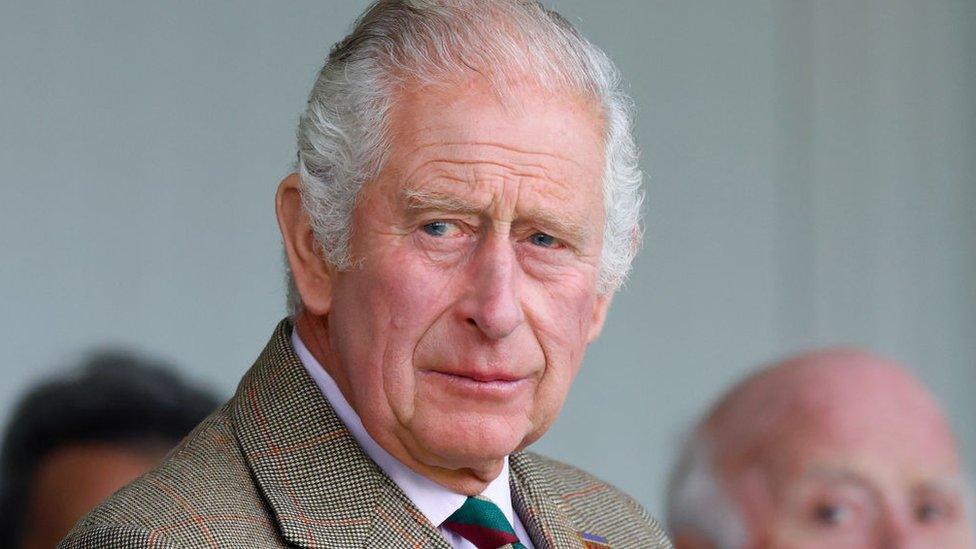King Charles III: First steps as King
- Published
- comments

Queen Elizabeth's eldest son Charles is now the UK's King.
He'll be known as Charles III and is head of state of the UK and the Commonwealth.
At the moment the Queen died, the throne passed immediately to the heir, Charles, the former Prince of Wales.
But there are a number of practical - and traditional - steps which he must go through to be crowned King.
What will he be called?
He will be known as King Charles III.
That was the first decision of the new King's reign. He could have chosen from any of his four names - Charles Philip Arthur George.
He is not the only one who faces a change of title.
Although he is heir to the throne, Prince William will not automatically become Prince of Wales - that will have to be conferred on him by his father.
He has inherited his father's title of Duke of Cornwall - William and Kate are now titled Duke and Duchess of Cornwall and Cambridge.
There is also a new title for Charles' wife, Camilla, who becomes the Queen Consort.
Formal ceremonies
The Palace has confirmed that Charles will be officially proclaimed King on Saturday.
This will happen at St James's Palace in London, in front of a ceremonial body known as the Accession Council.
This is made up of members of a group of senior MPs, past and present, and peers - as well as some senior civil servants, Commonwealth high commissioners, and the Lord Mayor of London.
At the meeting, the death of Queen Elizabeth II will be announced by the Lord President of the Privy Council (currently Penny Mordaunt MP), and a proclamation will be read aloud.
The wording of the proclamation can change, but it has traditionally been a series of prayers and promises - paying tribute to the previous monarch and support for the new one.
This proclamation is then signed by a number of senior figures including the prime minister, the Archbishop of Canterbury, and the Lord Chancellor.
The King's first declaration
The Friary Court at St James's Palace
The King attends a second meeting where he makes a declaration - in line with a tradition dating from the early 18th Century - and he will make an oath to preserve the Church of Scotland.
After a fanfare of trumpeters, a public proclamation will be made declaring Charles as the new King.
This will be made from a balcony above Friary Court in St James's Palace, by an official known as the Garter King of Arms.
He will call "God save the King", and for the first time since 1952, the national anthem will be played with the words "God Save the King".
Gun salutes will be fired in Hyde Park, the Tower of London and from naval ships, and the proclamation announcing Charles as the King will be read in in Edinburgh, Cardiff and Belfast.
The coronation
Elizabeth was crowned at her coronation on 2 June 1953. She stepped into the royal role when she was just 25 years old.
At this point Charles will formally be crowned.
Because of the preparation needed, the coronation is not likely to happen very soon after Charles's accession - Queen Elizabeth succeeded to the throne in February 1952, but was not crowned until June 1953.
For the past 900 years the coronation has been held in Westminster Abbey - William the Conqueror was the first monarch to be crowned there, and Charles will be the 40th.
At the climax of the ceremony, the Archbishop of Canterbury will place St Edward's Crown on Charles's head - a solid gold crown, dating from 1661.
This is the centrepiece of the Crown Jewels at the Tower of London, and is only worn by the monarch at the moment of coronation itself.
There will be music, readings and the ritual of anointing the new monarch, using oils of orange, roses, cinnamon, musk and ambergris.
The new King will take the coronation oath in front of the watching world and will receive the orb and sceptre as symbols of his new role.
The Archbishop of Canterbury will place the solid gold crown on his head.
Head of the Commonwealth
Queen Elizabeth II speaking at Commonwealth Heads of Government meeting in London
Charles has become head of the Commonwealth, an association of 56 independent countries and 2.4 billion people. For 14 of these countries, as well as the UK, the King is head of state.
These countries, known as the Commonwealth realms, are: Australia, Antigua and Barbuda, the Bahamas, Belize, Canada, Grenada, Jamaica, Papua New Guinea, St Christopher and Nevis, St Lucia, St Vincent and the Grenadines, New Zealand, Solomon Islands, Tuvalu.
